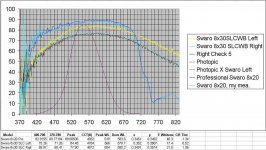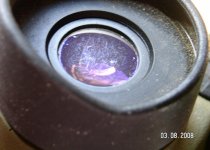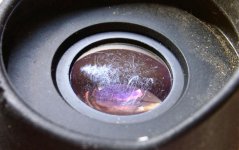Zeiss has a pdf booklet on cleaning optics. To put it briefly, they recommend the use of 100% certified pure cotton (to be wrapped around wooden sticks) and petroleum ether (boiling point max +44 C) or alternatively 85% petroleum ether + 15% isopropanol.
Heikki
Thanks Heikki, I will try to find that pdf. If you have a link, I would appreciate that.
My cleaning kit consists of the following:
Surgical type cotton swabs (lint free)
3 oz. Atomizer type of spray bottle filled with distilled water
Small camels-hair brush with bulb type air blower
Microfiber cleaning cloth (I prefer Leica, seems like smaller fibers, but I have not noticed any difference with other brands)
Zeiss lens cleaner for coated optics (3 oz. Bottle about $5)
I also have a couple of boxes of Bausch & Lomb Sight Savers but I never touch a coated optic with them. They are used for glasses and filters or similar items that collect a lot of fingerprints somehow.
Most of the time I find that I only need to clean the ocular end and very seldom need to do the objectives as often. I assume this is due to the moisture that the eyes generate.
I start by lightly spraying a cotton swab with distilled water and dabbing (not rubbing) particles off of the lens. I do this in direct sunlight (preferred) or a 150-watt halogen light. If there are very few particles on the lens and they are only around the edge, I will use a brush with very light, short strokes to remove them.
Next, I take a microfiber cloth and gently wipe from lens center toward the edge (not circular) and then look again for particles. If this does not do the job, then I will moisten cloth with distilled water and repeat with increased pressure, if needed (sometimes, I will just moisten with breath). I do not use tap water at all; my area has very hard water with a lot of calcium/lime in it.
The next step will be the lens cleaning solution, but I have had it for about 3 years and not opened the bottle yet. So far the steps up to wiping with a microfiber cloth have kept my lenses clean enough to suit me. Others may want to go farther.
The final thing to emphasize to clean the Microfiber cloth after each use. I use distilled water to rinse out (main thing is to get rid of any particulate that may have embedded itself).
Most will consider this overkill but I have found that if I make cleaning a structured PITA, I will tend not to over clean the optics.
I am sure that there are many more methods that will give satisfactory results and this is just my way. Find what works best for you. The main point is to watch for grit/sand or other particulate. That is were the trouble lies.
Ron






